Strawberry variety Kupchikha (earthworm)
Merchant's wife is a medium-ripening earthworm variety, for universal use. It is a hybrid of garden strawberries (strawberries we are used to) and nutmeg (European strawberries). Was bred by S. D. Aitdzhanova at the Kokinsky support point of the All-Russian Institute of Selection and Technology of Horticulture and Nursery. In 2014, the new variety began to undergo state tests and more recently, in 2017, it was included in the State Register of Plants of the Russian Federation. In the same year, a patent was obtained, its owners are the originator and the Federal State Budgetary Educational Institution of Higher Education "Bryansk State Agrarian University". The merchant's wife is a very successful hybrid, famous for its yield, size and taste of berries, unpretentiousness and good resistance to diseases and pests. Approved for cultivation in all regions of the country.
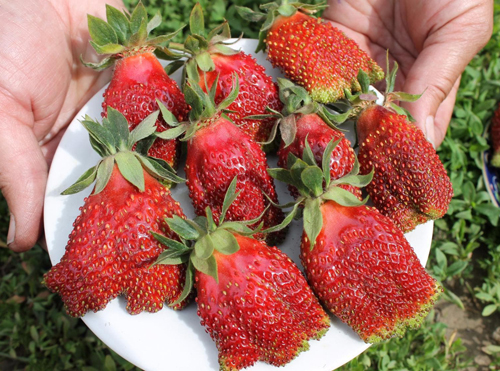
The plant is medium-sized, spherical, abundantly leafy. The variety forms a mustache little. The mustache is of medium length, pale red in color. The leaves of the earthworm are medium, strongly wrinkled and strongly ribbed, concave, slightly pubescent, have a green color with shine. The teeth of the leaf plate are obtuse, wide. The shape of the middle leaf lobe is rounded, the base of the middle leaf is obtuse. The petiole of the middle lobe of the leaf plate is longer than the lateral ones. The petiole is rather long, with strong pubescence, the hairs are directed slightly downward. Stipules are short, narrow, green in color. The flowers are large, untwisted, white. The merchant's wife forms bisexual flowers and does not need additional pollination. The inflorescence is multi-flowered, semi-spreading. Strawberry blooms are very abundant, a lot of berries are tied. Peduncles are long, strongly pubescent, located at the level of leaves, very strong, but under the weight of large fruits they can be laid on the ground. The stalks are of medium length, thin.
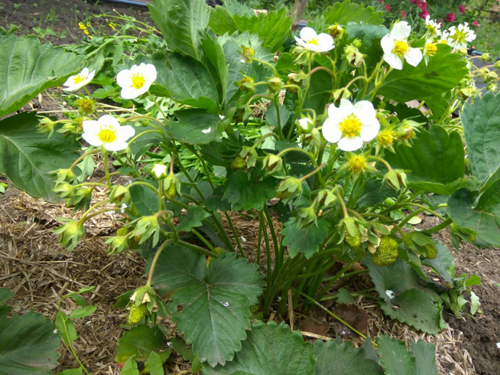
The berries of the variety are almost cylindrical in shape, with a neck, the largest specimens can be slightly comb-shaped. The skin is dark red, evenly colored. Achenes are yellow. The pulp of the earthworm also has a dark red color, rather dense, slightly juicy, with a specific spicy strawberry aroma with a nutmeg tint. The taste of hybrid strawberries is very sweet, practically without acidity, versatile, with a pleasant spicy aftertaste. The pulp is very tender, melts in the mouth. It contains: sugar - 5.8%, acid - 0.6%, vitamin C - 78 mg%.
In use, the earthworm is universal, the fruits are excellent fresh, ideal for processing, as well as freezing, especially gardeners praise the Kupchikha jam - it turns out to be very rich and sweet. Strawberries are also suitable for transportation and short-term storage, do not wrinkle or flow during transportation, and remain dry and tidy after picking. Thus, the variety is good both for personal consumption and for sale on the market, however, according to gardeners' reviews, the berries are so tasty that they simply do not remain for sale.
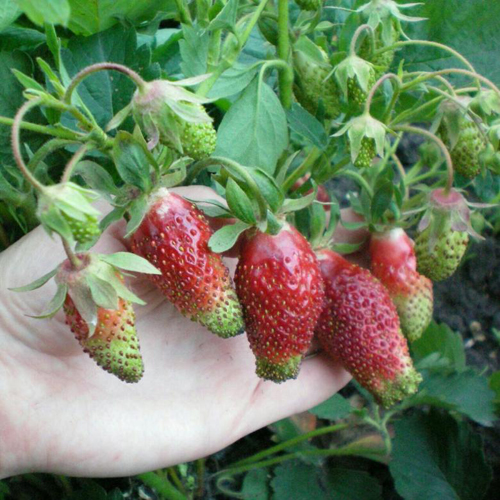
According to the originator, the average weight of the fruit is approximately 3.7 grams, the maximum is 17 grams. According to nursery data, berries weighing up to 60 grams can be formed, and according to the observations of gardeners, the average weight of the earthworm hovers around 20 grams. This difference in numbers is quite easy to explain. The fact is that the berries of a hybrid strawberry are very heterogeneous in size and weight, both large and small are formed. Some specimens can be up to 5-6 cm long. The merchant's yield declared by the originator is 135 c / ha. With moderate agricultural technology (without abundant feeding and strict control over the growing conditions), it is possible to collect 300-350 grams of fruit from one plant. The variety ripens in the middle or mid-early period, depending on the climatic conditions, around the end of May or the beginning of June. Fruiting in our heroine is rather compressed, lasts up to 20 days, the berries do not shrink after the first harvest.
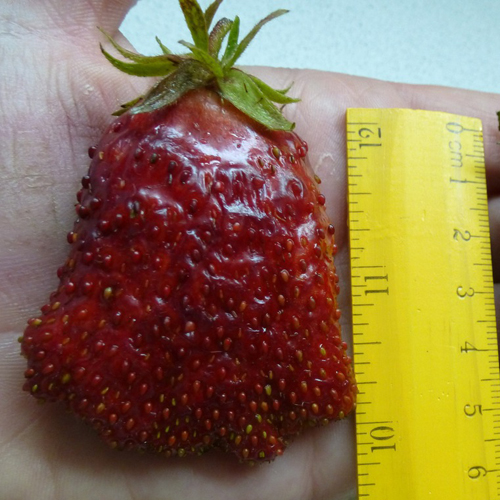
According to the State Register of Breeding Achievements of the Russian Federation, the earthworm has relative winter hardiness, average drought resistance and high heat resistance. According to the experience of gardeners from different parts of Russia, all these characteristics of the Merchant are at a high level! It is exceptionally "tenacious", it endures even frosty winters with little snow, feels great in dry seasons, does not bake in the heat. However, if you do not follow the collection dates, the berries may be slightly baked in the sun. The list of resistances also includes the shade tolerance of the earthworm, thanks to which plants can be planted on a plot in partial shade or under trees. According to the originator, the variety is slightly damaged by diseases and pests. Gardeners boldly confirm this statement. Even without preventive treatments, strawberries are rarely affected by diseases, and with minimal preventive measures, they will be completely invulnerable. As for pests, opinions differ. So, some note that the strawberry mite bypasses the Merchant's wife, while others say that she is still affected by the tick, but insignificantly.
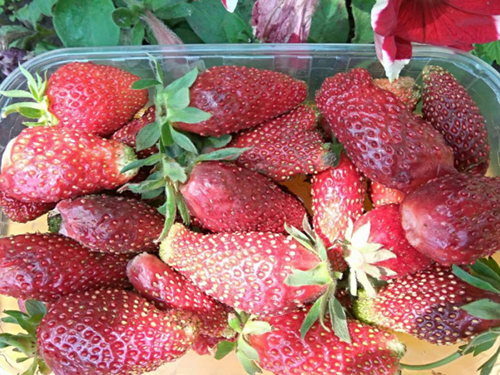
Gardeners' comments also differ regarding the dependence of yield and plant health on the weather conditions of the season. Some claim that even in rainy periods, the berries of this variety do not rot and no other problems are observed. Others say that with abundant rainfall, the fruits begin to rot en masse. Well, who is right and who is wrong can only be verified by personal experience. Also, there are conflicting reviews about the formation of the Merchant. For some, hybrid strawberries form quite a few whiskers, and for others, they form an excessive amount. It should be said that this factor depends on the age of the plants and the cultivation technique.
In the care of the earthworm, it is unpretentious, requires only the most standard measures - watering and feeding, loosening the soil, weeding, preventive treatments for diseases and pests. As for the last point, it is worth noting that the variety is perfect for organic farming and does not really need "chemistry" - its immunity is quite enough to resist ailments, and there will be enough folk remedies. The merchant's wife does not make high demands on the amount of fertilizer, but she will respond very well to additional feeding. The best option would be to apply fertilizers three times - before strawberry flowering, before fruiting and after harvesting. Until the moment of flowering, preference is given to organics, then they pay attention to mineral complexes. An excellent result will also be obtained by foliar feeding on the leaves with a mixture of potassium permanganate and boric acid (0.2% solution) during the extension of the peduncles.
And a few more words about agricultural technology. As for watering, we can say the following - avoid excessive waterlogging or drying out of the soil. Water the dugout regularly and in moderation. Another point - observe the collection deadlines. In general, even overripe berries do not crumble from the bush, however, they are more susceptible to the harmful effects of the sun's color and can be heavily baked, turning into a withered likeness of something incomprehensible. By the way, if the variety grows in partial shade, this problem is not terrible for the fruit, but another one appears - the likelihood of berry rotting increases. And while we're on this topic, it's worth mentioning that plants feel quite comfortable in shaded areas, but their yield will be slightly less than if they grew in a well-lit area. But the taste of the berries will be delicious anyway!
In the end, I would like to summarize. The merchant's wife is a kind of "breakthrough" in the strawberry world, which made him look at the landowner from a different angle.On the market we are used to seeing mainly strawberries, and besides, not ordinary, and sometimes gigantic, with various parameters of taste, aroma, shapes and sizes. It is much more difficult to meet a digger on the market, and what can I say, in terms of yield, it will never be able to compete with strawberries. But our heroine made me think - is the quantity so important when the quality is so high? Indeed, all gardeners confidently claim that the taste and aroma of the Merchant's berries are simply excellent, and in comparison with any other varieties, our heroine is a favorite in terms of consumer qualities. Farmers say that the demand for such a treat is very high, and therefore the variety can be grown commercially without worrying about a lack of profit.
In addition, this dugout has everything that a simple gardener needs. Undemanding to growing conditions, unpretentious care, disease resistance, stable yield - all this can be boasted by the Merchant. But the main thing, of course, is its taste. Households will definitely love her forever! As for the shortcomings, so far they have not been found, or the data on them are too contradictory. The variety is quite "young" and is just beginning to gain fame, but already now it has gained very great popularity and many admiring reviews.









Zemklunika Kupchikha has been a favorite in my collection of garden strawberries for many years. Every year I look forward to a white blanket on her bushes during flowering. It was not in vain that I wrote "white blanket", because at this time the bushes are simply strewn with many peduncles towering over the foliage. This variety is unusually productive. With decent agricultural technology, the bushes are simply strewn with bunches of berries. The berries taste very much like wild strawberries, they are just as aromatic and sweet. They make wonderful strawberry chips, aromatic jam that will preserve the taste of summer and everyone's favorite strawberry aroma. The variety gives a lot of mustache, which may be a disadvantage for some. It hibernates in Siberia without any problems, I do not make additional shelters for the beds.